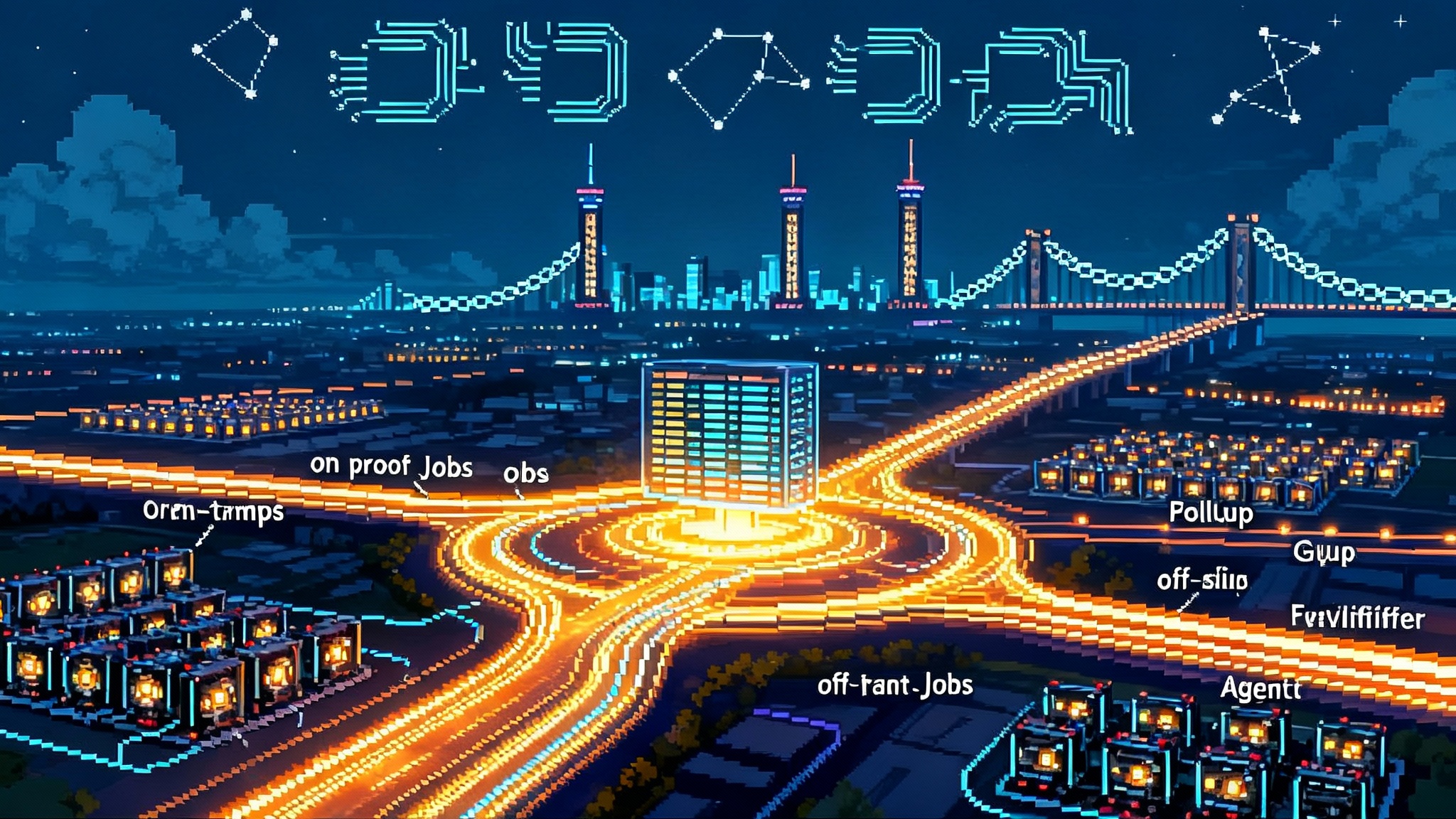Proof Markets Hit Mainnet, ZK Compute Becomes Commodity
Succinct and Boundless have switched on live proof markets, turning zero-knowledge proving into an on-demand commodity. Here’s how proofspace reshapes rollup costs, interoperability, and the next wave of onchain agents.

The week proving became a market
For years, blockspace felt like the scarce resource that defined crypto. This summer and fall, another scarce resource came online as a market in its own right: proving. In August 2025, Succinct switched on its Prover Network on mainnet, a two-sided exchange where applications buy zero knowledge proofs from competing provers (mainnet launch of Succinct Prover Network). In September 2025, Boundless, incubated by RISC Zero, followed by turning its incentivized testnet into a production network on Base (Boundless launches mainnet on Base).
Call it proofspace. Like blockspace, it is scarce, measurable, and priced. Unlike blockspace, which is protected by validators on a single chain, proofspace can be supplied by any qualified node operator with the right hardware and the right prover software. That turns proving into a commodity that developers can buy exactly when they need it and only in the amount they need.
What is a proof market, in plain terms
A proof market is an exchange for verifiable computation. Think of it like a rideshare marketplace, but for math. A developer posts a job, which is a bundle that includes a program, inputs, a target proof system, and constraints such as maximum latency or maximum price. Provers are the drivers. They run specialized software on GPUs or other accelerators, generate a proof that the computation was done correctly, and submit it back. The protocol acts as dispatcher and escrow. It matches jobs, holds funds, verifies proofs, pays winners, and penalizes cheaters.
Three components help it work at scale:
- A common virtual machine. Systems like SP1 and R0VM define how arbitrary programs are translated into circuits, so buyers can bring their own code, not just prebuilt circuits.
- A bidding and routing layer. Jobs are priced through auctions or posted rates. Routing favors provers that meet the required service level objectives under current load and price.
- A verification and settlement layer. Proofs are verified onchain or in a trust-minimized verifier, then payments and any slashing events are settled.
The result is a compute grid that guarantees correctness as a property of the math itself. The market discovers price and allocates capacity to the most urgent or best paying workloads in real time.
Why this changes rollup economics
Rollups pay for three things today: data availability, execution, and proving. Data availability and execution are bound to the chain’s design, but proving is elastic. If proving capacity can be rented on demand, a rollup can align cost with usage rather than peak provision for the worst case.
- Bursty traffic becomes affordable. During airdrops or liquidations, a rollup can buy more proofs for a few hours rather than overbuild permanent infrastructure. When demand falls, costs fall too.
- Finality targets can be tuned per application. A payment app might request fast proofs at higher cost to shorten withdrawal windows, while a batch settlement app can accept slower proofs for lower fees.
- Specialized hardware is pooled. Instead of each chain managing its own proving farm, the market amortizes hardware across many buyers, which typically pushes unit prices down and increases supply resilience.
If the long-run cost of posting data falls with better compression and shared blobs, proving becomes the dominant variable cost for high-throughput systems. A functioning market gives rollups a lever to manage that cost without compromising correctness.
The interoperability unlock
Cross-chain messaging has always wrestled with trust models. Multisigs are fast but trusted. Light client bridges are secure but heavy. Zero knowledge proofs bridge this gap by letting one chain verify a succinct proof of another chain’s state transition or finality. Proof markets make this practical.
A messaging protocol can request proofs of a consensus client snapshot on demand, then use the verified proof to finalize messages. A Bitcoin-aligned rollup can prove transactions to an Ethereum verifier or vice versa. With markets live, the bridge does not need its own prover fleet. It pays for a proof only when there is a message to move. That reduces idle capital and makes cross-chain verification accessible to smaller teams. For how bridge design is evolving on Bitcoin, see our Bitcoin Bridge Wars analysis. On the Ethereum side, the push for better coordination aligns with Ethereum’s interop moment and intents.
How a proof market job actually flows
-
A developer packages a job. The job contains the program, inputs, a target proof system, a maximum acceptable latency, and a maximum price. It may also include a stake requirement for provers to increase security for high-value jobs.
-
The market posts the job to an orderbook. Metadata is visible to provers, while sensitive inputs can be committed to and revealed only to the winning prover if privacy is required.
-
Provers bid. They signal price, estimated completion time, and available hardware. Some markets use continuous double auctions, others use posted price queues with priority for staked or reputation-rich provers.
-
The dispatcher assigns the job. Routing considers price, past reliability, current queue depth, and the job’s constraints.
-
The prover generates the proof. This is the heavy part. It may split across GPUs, use recursion, or outsource subjobs to specialized micro provers. The prover then returns a proof and a receipt.
-
The verifier checks the proof and settles. If the proof verifies, funds are released. If it fails or times out, the job is re-auctioned and the failing prover may be penalized.
-
The application consumes the proof. It posts the proof to its target chain or a verification contract, triggers state transitions, and records the result for audit.
In a mature market, all of this is API driven. The buyer sets a budget and a deadline. The network handles routing, retries, and disaster recovery.
Where the savings come from
Proving is a compute-intensive pipeline. Savings emerge when the pipeline can be sized to real use instead of peak use, when utilization rises across a shared pool, and when competition pressures providers to optimize their stacks. Three technical levers matter most:
- Hardware efficiency. Provers that squeeze more constraints per second from the same GPU win more bids. Markets reward better kernels, better batching, and better memory layouts.
- Algorithmic improvements. Faster multi-scalar multiplication, better lookup arguments, and recursion that compresses many small proofs into one larger proof all reduce total work per job.
- Scheduling. Smart batching of similar jobs reduces amortized overhead. For example, a rollup that posts 100 batches per hour might pay less if a market bundles those into 10 larger composite proofs that still meet its latency target.
None of these levers changes the cryptographic guarantees. They shift who performs the work and when, which is exactly what markets are good at coordinating.
What builders can do now
You do not need to redesign your stack to test a proof market. Practical steps for the next two sprints:
- Integrate the client SDK. Start by wrapping your existing prover call behind a feature flag. Swap in a market client for a subset of jobs, such as nightly state snapshots or low-priority withdrawal proofs. Measure latency, failures, and unit cost.
- Define latency budgets per route. For cross-chain messages, classify routes into fast and slow paths. Buy fast proofs for user exits and liquidity-sensitive actions. Buy slow proofs for archival sync or oracle updates.
- Offload heavy subroutines. If your rollup uses onchain fraud proofs or complex validity proofs for a few transactions, carve those out as separate jobs and send them to the market rather than bumping the gas limit or delaying the whole batch.
- Set minimum security parameters. Require provers to post stake or to meet audited software requirements for jobs above a threshold value. Make these values explicit in your job template.
- Build a fallback. If the market is congested, your code should be able to fall back to your internal prover or temporarily raise the price cap to clear the job queue. Test this path in staging.
- Instrument receipts. Store proof job metadata, final price, completion time, prover identity or attestation, and verifier logs. This becomes the backbone of your post mortems and your procurement strategy.
The new blockspace
If blockspace is space in a ledger, proofspace is time on a verifiable computer. Markets for both now clear in parallel. Here is what that implies for architecture and business models:
- Separation of concerns. Execution engines focus on deterministic state transitions and data availability. Proving becomes a separate layer with its own fee markets and its own supply curve.
- Cross-domain scalability. A single proof can move value or information across many chains. Price discovery for that proof happens once, while the verified result can be reused or recursively compressed.
- New roles for operators. Just as validators and sequencers emerged around blockspace, specialized prover operators will emerge around proofspace. They will differentiate on hardware fleets, custom kernels, reliability, and geographic distribution, mirroring trends from Solana’s multi-client era with Firedancer.
- Service level agreements become products. Some buyers will want soft real-time guarantees with penalties for missed deadlines. Others will pay rock-bottom prices for batch jobs that can finish overnight. These distinctions can be written directly into job templates and enforced by the protocol.
The near-term risks to track in Q4 2025
- Prover concentration. Early markets often see a few large operators win most bids because they have the cheapest hardware and the best schedulers. Track the prover Nakamoto coefficient, the share of jobs cleared by the top five provers, and geographic concentration. If your critical path jobs often land on the same operator, diversify with allowlists or stake-weighted routing.
- Token and fee sustainability. Some networks bootstrap with incentives or fixed-rate subsidies. This can mask true unit economics. Watch for the ratio of organic job fees to incentive payouts. If the token’s primary sink is prover rewards without buyer growth, prices may rise or quality may fall when subsidies taper.
- Latency and jitter. Average times can look great while tail latencies break user experience. Instrument the 95th and 99th percentile times from job posted to verified proof. Compare those to your app’s specific service level objectives for withdrawals, message finality, or oracle updates.
- Security service levels. A proof can verify and still be unsafe if the wrong circuit definition, the wrong public inputs, or a misconfigured verifier is used. Demand circuit fingerprints in receipts, versioned verifiers, and third-party audits. For high-value jobs, require provers to run attested binaries and hardware. Define clear penalties for incorrect proofs, late proofs, and provers that disappear mid job.
- Dependency risk. If your chain or bridge depends on a single market, treat that as a vendor dependency with its own incident response runbook. Simulate network-wide congestion and practice your fallback plans.
What this means for the AI agent wave
Onchain agents are only as useful as the compute they can verifiably perform. Proof markets turn large, expensive tasks into bought services. An agent that needs to verify a model inference, score a batch of transactions, or check a strategy can post a job with a price cap and a deadline. The proof arrives with a receipt and a hash bound to the inputs, so the downstream contract can trust the result. That makes agents safer to deploy and easier to reason about than opaque offchain calls.
In practice, teams should start by moving expensive but low-risk tasks first, such as summarization, ranking, or fraud scoring. Keep user-facing inference on a slower path until you are confident in latency and cost. Over time, as markets get deeper and verifiers get faster, more of the agent loop can run under proofs.
A checklist for technical due diligence
- Ask how jobs are priced. Is it a continuous auction, a posted rate, or a hybrid, and can you set hard caps and deadlines per job.
- Inspect failure handling. What happens on timeouts, invalid proofs, or verifier upgrades. Are partial results recoverable.
- Review the verifier path. Where do proofs verify, on which chain, and who upgrades the verifier contract. Is there a pause switch for emergencies.
- Verify identity and attestation. Do provers offer remote attestation or signed build manifests. Can you require them for high-value jobs.
- Read the circuit catalog. Can you bring your own programs, and are there reference circuits for common tasks like state root proofs, finality proofs, and Merkle proofs.
- Check payout risk. How are payments escrowed and released. What slashing conditions exist, and are they enforced onchain.
The next twelve months
We will likely see three accelerations. First, deeper liquidity as more provers and more buyers join, which should tighten spreads and improve reliability. Second, specialization, with operators focusing on particular proof systems and workloads, from rollup batch proofs to cross-chain consensus snapshots. Third, standardization, as job templates and receipt schemas converge so that proofs and receipts are portable across markets.
Proof markets do not replace blockspace. They complement it by turning verifiable compute into a utility that anyone can buy. With mainnets live, the theory phase is over. The hard work now is builder driven, measured in dashboards and post mortems, and paid for one proof at a time.
Closing thought
When computation is bought like power from a grid, architecture changes. Teams ship faster because they rent when they need to, and they trust the math because the proof is the product. That is the quiet breakthrough of this cycle, and it is just getting started.








